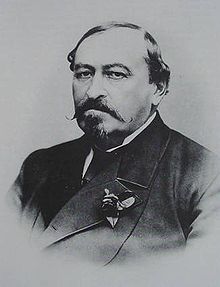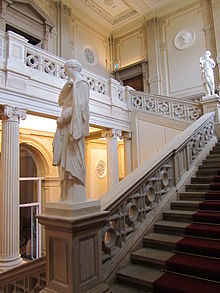| Revision as of 11:01, 18 December 2024 editMaybeItsBecauseImALondoner (talk | contribs)Extended confirmed users16,294 edits →Displays← Previous edit | Revision as of 11:12, 18 December 2024 edit undoMaybeItsBecauseImALondoner (talk | contribs)Extended confirmed users16,294 edits →ArchitectureTag: Disambiguation links addedNext edit → | ||
| Line 66: | Line 66: | ||
| == Architecture == | == Architecture == | ||
| ] | ] | ||
| ] |
] | ||
| The building is mainly made up of ] sandstone, with some stone from ] in Saxony. Franz von Neumann based his designs on existing museum buildings built between 1800 and 1850, but did also introduce ideas of his own, which in turn became ground-breaking for later buildings. The ] was the main influence on the facade. | |||
| Franz von Neumann orientierte sich in seinen Plänen an bestehenden Museumsneubauten aus der ersten Hälfte des 19. Jahrhunderts, verwirklichte aber gleichzeitig auch eigene Ideen, die wiederum für spätere Bauten wegweisend wurden. Für die Gestaltung der Fassade, war sicherlich Versailles die wichtigste Inspiration. Das Mauerwerk besteht zum größten Teil aus ] Sandstein, teilweise kamen auch Steine aus ] in Sachsen zum Einbau. | |||
| Durch eine Glaskuppel auf der Mitte des Gebäudes, den repräsentativen Haupteingang und durch die pavillonartige Gestaltung der Ecken wird der mittlere Teil besonders betont. Zwei von Bildhauer ] modellierte sitzende Löwen an der Freitreppe und zwei ] Sandstein-Statuen im Eingangsportal empfangen den Besucher. Auf den Ecken der ] befinden sich Figurengruppen, die Kunst und Wissenschaft symbolisieren. | |||
| The complex is centred on a glass dome over a central ] (housing a life-size 1882 ] statue of Ernst II wearing the robes of a Knight of the ]) and the main entrance (with two seated lions on the main staircase by sculptor ] and two ] sandstone statues in the entrance hall), whilst its corners are designed like pavilions. On the corners of the ] are groups of figures symbolizing art and science. | |||
| Im Inneren führt der Weg zu den Sälen und Kabinetten durch ein prächtiges sehr klar strukturiertes ]. Italienischer Marmor und ein mehrfarbiges Steinmosaik bestimmen das Gesamtbild des Raumes. Im Souterrain gibt es eine Reihe kleinteiliger Kabinette, darüber im Erdgeschoss befinden sich zwei großzügige, von Licht durchflutete Säulenhallen und im Obergeschoss Oberlichtsäle, die wiederum von Kabinetten umgeben sind. Die gläserne Kuppel ist über einem zentralen ] errichtet, in dessen Mitte eine lebensgroße Bronzeskulptur Ernsts II. in der Kleidung eines Ritters vom ] steht, die vom Bildhauer ] 1882 gestaltet wurde.---> | |||
| Inside, the path to the halls and cabinets leads through a magnificent, very clearly structured ]. Italian marble and a multi-coloured stone mosaic determine the room's overall appearance. In the basement are a series of small cabinets, whilst on the ground floor there are two spacious, light-flooded halls supported by pillars and on the upper floor are halls with skylights filled with cabinets. | |||
| == Bibliography == | == Bibliography == | ||
Revision as of 11:12, 18 December 2024

The Ducal Museum Gotha (German - Herzogliche Museum Gotha) is a museum in the German city of Gotha, located in the Schlosspark to the south of the Schloss Friedenstein. Its collection was the art collection of the former Duchy of Saxe-Gotha, consisting of Egyptian and Greco-Roman antiquities, Renaissance paintings such as The Gotha Couple, Chinese and Japanese art, and sculptures from various eras.
Reopening in 2013, it is housed in a 19th century Neorenaissance building owned by the city, whilst the museum itself is managed by the Friedenstein Castle Gotha Foundation, founded in 2004. Martin Eberle has been the Foundation's director since 2007.
History

19th century
20th century
21st century
List of directors
Museums
- Carl Aldenhoven (1879–1890)
- Karl Purgold (1890–1934)
- Eberhard Schenk zu Schweinsberg (1934–1946)
- Bruno Voigt (1946–1954)
- Michel Hebecker (1986–1992)
- Rudolf Funk (1992)
- Klaus Roewer (1995–1997)
- Elisabeth Dobritzsch and Ulrich Mahlau (1997–1998)
- Klaus Roewer (1998–1999)
- Rainer Samietz and Ulrich Mahlau (1999–2001)
Foundation
- Katharina Bechler (2004–2006)
- Ulrich Mahlau (2006–2007)
- Martin Eberle (2007–2018)
- Tobias Pfeifer-Helke (2019-)
Displays
The basement displays show ancient Greek, Roman and Egyptian art and 18th century Italian cork models of buildings from those civilizations. Sculptures and temporary exhibitions are housed on the ground floor, whilst the first floor houses paintings (such as Dutch Renaissance works and ones by Lucas Cranach the Elder), Chinese porcelain, Japanese lacquerware and other East Asian art.
-
Fragment of a sarcophagus from Attica, 3rd century AD
-
The Gotha Couple, 1480
-
 Cranach the Elder, Christ and Mary Magdalene, 1516–20
Cranach the Elder, Christ and Mary Magdalene, 1516–20
-
 Cranach the Elder, Law and Grace, 1529
Cranach the Elder, Law and Grace, 1529
-
Gotha Altarpiece, 1540
-
 Caspar David Friedrich, Cross in the Mountains, 1823
Caspar David Friedrich, Cross in the Mountains, 1823
-
Bronze miniature copy of the Farnese Bull by Adriaen de Vries, 1614
-
 Abraham de Vries, Portrait of an Unknown Man, 1643
Abraham de Vries, Portrait of an Unknown Man, 1643
-
Geniuses of Concord and Harmony, China, c. 1700
-
Yixing teapots, 18th century
-
Cork model of the Temple of Portunus, 18th century
-
Cork model of the Arch of Constantine, 18th century
Architecture


The building is mainly made up of Seeberg sandstone, with some stone from Pirna in Saxony. Franz von Neumann based his designs on existing museum buildings built between 1800 and 1850, but did also introduce ideas of his own, which in turn became ground-breaking for later buildings. The Palace of Versailles was the main influence on the facade.
The complex is centred on a glass dome over a central octagon (housing a life-size 1882 Christian Behrens statue of Ernst II wearing the robes of a Knight of the Order of the Garter) and the main entrance (with two seated lions on the main staircase by sculptor Franz Melnitzky and two allegorical sandstone statues in the entrance hall), whilst its corners are designed like pavilions. On the corners of the attic are groups of figures symbolizing art and science.
Inside, the path to the halls and cabinets leads through a magnificent, very clearly structured vestibule. Italian marble and a multi-coloured stone mosaic determine the room's overall appearance. In the basement are a series of small cabinets, whilst on the ground floor there are two spacious, light-flooded halls supported by pillars and on the upper floor are halls with skylights filled with cabinets.
Bibliography
- (in German) Martin Eberle: Herzogliches Museum Gotha. Münzkabinett, Kupferstichkabinett, Ostasiatika. Mitteldeutscher Verlag, Halle (Saale) 2013, ISBN 978-3-95462-017-3.
- (in German) Stiftung Schloss Friedenstein Gotha (Hrsg.): Museen der Stiftung Schloss Friedenstein Gotha: Schlossmuseum, Museum der Natur, Museum für Regionalgeschichte und Volkskunde. Deutscher Kunstverlag, München/Berlin 2007, ISBN 978-3-422-06620-5.
- (in German) Wolfgang Zimmermann: Der Bau des Herzoglichen Museums zu Gotha (1864–1879). In: Harald Bachmann, Wener Korn, Helmut Claus, Elisabeth Dobritzsch (ed.s): Herzog Ernst II. von Sachsen-Coburg und Gotha, 1818–1893 und seine Zeit, Jubiläumsschrift im Auftrag der Städte Coburg und Goth. Maro Verlag, Augsburg 1993, ISBN 3-87512-198-8, S. 249–261.
External links
- (in German) Herzogliches Museums Gotha. In: StiftungFriedenstein.de
- (in German) Herzogliches Museums Gotha. In: Museen.Thueringen.de
- (in German) Herzogliches Museums Gotha. In: Museum.de
- (in German) Website des Freundeskreises Kunstsammlungen Schloss Friedenstein Gotha e. V.
References
- (in German) Homepage mitteldeutscher verlag
50°56′36″N 10°42′21″E / 50.94333°N 10.70583°E / 50.94333; 10.70583
Categories: